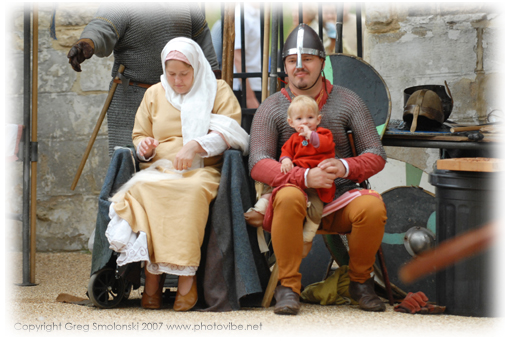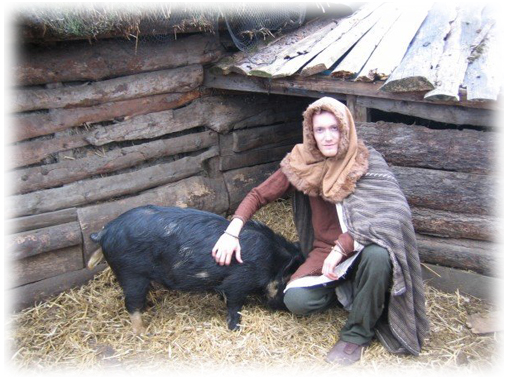 Some Words On Our Costume
Some Words On Our Costume
As re-enactors we aim to give a picture of what life could have been like in the Early Mediæval period; this means that our costume needs to look as much like the clothes people would have worn at the time as possible. To give you an idea of what Anglo-Saxon clothes were like we have some short articles on female costume, male costume and the fabrics that people used to make them. More detailed articles on cloth and clothing can be found on our wiki.
Oxford was outside the Danelaw, so most of us re-enact Anglo-Saxons. However, it was a centre of trade in those days, where all kinds of people could be encountered. Some people like to dress as rich Lords, others as poor peasants. Some prefer to represent Vikings, others want to be amongst William's men as the Normans land at Pevensey - everyone is free to choose whatever ethnic group they would like to belong to. But beware, you may find your friends on the other side of the shield-wall one day.
One word on the authenticity of our costume: Wearing authentic costume is only required when we are taking part in public performances such as shows. People are asked to turn up in costume to events that we organize just for ourselves, such as fires and feasts. In these events authenticity is more relaxed. (The Wychwood chain mail bikini has now been modelled by several adventurous members...)
Making your own costume out of the most authentic materials may be quite pricey. Many of us tend to use cheaper alternatives. This is acceptable as long as they are substituted for materials that look alike. For example, linen may be substituted by certain types of calico or cotton. Authentic materials can be bought at good prices at re-enactment markets, to which we make regular pilgrimages.
A basic set of costume does not have to be very expensive at all. A tunic (or a dress), a pair of trousers and a belt is really all you need to pass yourself off as an Anglo-Saxon. As we make most of our kit ourselves all you need to get is the material, and we'll show you how to turn it into an Anglo-Saxon costume.
 Grandmother, Grandmother, I Need Your Help
Grandmother, Grandmother, I Need Your Help
I've Got Lots Of Material, And I Am Afraid...
You don't need to resort to your grandmother's sewing skills in order to get yourself a costume (although people have been known to do so...) Every week of Oxford term time we get together for what is formally known as kit making evenings. On these occasions you can learn more about the costumes we wear, make your own costume, hear the latest gossip in town, or simply lie on some maid's lap - it's up to you.
Some parts of our costume cannot really be made at the regular kit making evenings, so we have extra Craft Days dedicated to them. If you want to make your own shield or knife, learn how to spin wool using a drop spindle or how to use an Anglo-Saxon loom, a Craft Day is your chance to do so. Usually fading into video evenings, Craft Days are an excellent opportunity to learn more about your costume and also to get the slightly more tedious bits of costume making done with a lot of help and in good company.
